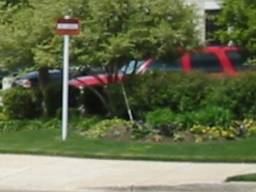Framework 4 (Last updated: October 25, 2019)Framework 3 (Last updated: February 6, 2017)Framework 2 (Last updated: October 8, 2006)Framework (Last updated: October 8, 2006)Libraries (Last updated: September 16, 2004)Really old framework (Last updated: September 16, 2004)
High Quality Texture Compression
Friday, June 2, 2006 | Permalink
This demo shows a way to achieve higher quality texture compression than DXT1 at a bit higher bitrate by using 3Dc+. Don't complain about the lack of artwork or eyecandy in this demo (it's just a single textured quad) since that's not the point, but the point is to illustrate the quality difference between this method and DXT1.
In JPEG compression the first step is to convert RGB to YCbCr, a color space based on luminance (Y) and chrominance (Cb and Cr). The rationale for this is that the eye is much more sensitive to luminance information than chrominance, and by converting it to this color space we can sample luminance at full rate and chrominance at a lower rate. Typically JPEG files sample luminance at 1x1 and chrominance at 2x2, which already cuts down the data to half the size at nearly no visible quality degradation.
The method I use here is similar to this first compression step in JPEG, but I take it one step further by storing the Y channel in an ATI1N texture and CbCr in a lower resolution ATI2N texture. This essentially gives you a 6bpp texture format, with a lot better quality than DXT1. Now it's true that DXT1, which is 4bpp, looks good with most textures, but there are exceptions. DXT1 doesn't perform very well with photographical images, some textures with smooth gradients, some very detailed textures, non-uniformly colored textures, textures with diagonal features or features that otherwise lines up badly with the 4x4 pattern. In these cases this method looks much better. Additionally, it's in many cases possible to sample CbCr at 4x4 without significantly reducing quality, resulting in 4.5 bpp. This will almost always look better than DXT1, but could see more color bleeding than 6bpp.
Decoding YCbCr into RGB in the shader is very cheap and takes only three instructions. Generally speaking this method has quality close to RGB8 but performance close to DXT1. The default view is a bit zoomed in so you can judge quality, where performance difference is small since it's all magnified, but if you zoom out so you get most of the texture visible covering the screen you'll see bigger performance difference.
In addition to using ATI1N and ATI2N I've also added similar compression using DXT1 and DXT5. This gives the same performance as the 3Dc modes, but visibly worse quality. It's still better than DXT1 though.
Use the keys 1-6 to toggle between DXT1, YCbCr DXT/3Dc & 4.5bpp/6bpp and RGB.
This demo should run on Radeon 9500 and up and GeForce FX and up.






 Executable
Executable Source code
Source code